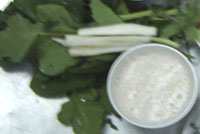
Made in Yemen – Ramadan delicacies [Archives:2006/984/Last Page]
September 25 2006
 |
Every issue, we will bring you recipes of a number of Yemeni traditional foods made especially during Ramadan. We will also provide you with health tips regarding some of the food items for your benefit. Bonn appetite!
Hamidha – (Sour chutney)
Ingredients:
One tbsp Fenugreek powder
Two spoons sugar
1/2 cup vinegar
Procedures:
1. Soak the fenugreek in cold water for 4 fours at least (the longer the better)
2. Drain the old water and add new cold water
3. Blend the fenugreek with hand or with blender for 10 minutes then soak for five minutes
4. Repeat step three until mixture is white and creamy
5. Add half vinegar and sugar and mix well
6. Serve with radish
Rawani:
Ingredients:
7 eggs
3 cups of flour
one tbsp backing powder
one tbsp oil
2 glasses of syrup *
Instructions:
1. Prepare syrup and let cool
2. Heat the oven to 200 degrees
3. Separate white eggs from yolk
4. Blend egg whites in blender very well for five minutes
5. Blend yolks separately
6. Mix the two ingredients together with backing powder and stir
7. Add flour one spoon at a time while stirring continuously
8. Spread oil in the backing plate and pour batter
9. Back in oven for 5-7 minutes until golden
10. Make small holes with fork on the cake and pour syrup
11. serve cold
* Syrup:
Mix two glasses of water with three cups of sugar and _ lemon juice and two cardamom and two cloves and boil until mixture is thick and yellowish.
About Fenugreek
What is it?
Fenugreek is commonly found growing in Mediterranean regions of southern Europe, where both the seeds and leaves are used primarily as a culinary spice. The seeds of the fenugreek herb are an effective nutritional supplement and have also been used by herbalists for many centuries for the health benefits it provides.
Health Benefits of Fenugreek
The active constituents in fenugreek are alkaloids, lysine and L-tryptophan. It also contains steroidal saponins (diosgenin, yamogenin, tigogenin, and neotigogenin) and mucilaginous fiber which are believed to be responsible for many of the beneficial effects fenugreek exhibits.
The chemical compounds found in fenugreek have the ability to aid the digestive process. Consequently, when taken with meals it is believed that fenugreek is able to slow down the rate at which sugars are absorbed into the body, whereby regulating blood sugar levels.
Additionally, studies indicate that 4-hydroxyisoleucine (an amino acid) found in fenugreek may induce or promote the production of insulin when blood sugar levels are elevated.
In studies of animals and humans with both diabetes and high cholesterol levels, fenugreek appeared not only to regulate blood sugar levels but also lower levels of harmful cholesterol. However, in studies of those who did not have diabetes, a similar effect was not reported
As mentioned previously fenugreek contains a substantial amount of mucilaginous fiber. The mucilage found in fenugreek does not dissolve but instead swells when mixed with fluids. Since the body cannot digest the mucilage from fenugreek it is believed to be an effective laxative
As an external application fenugreek may sooth irritated skin and relieve surface aches and pains.
Source: nutrasanus.com
——
[archive-e:984-v:14-y:2006-d:2006-09-25-p:lastpage]


